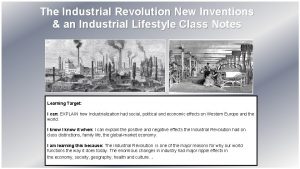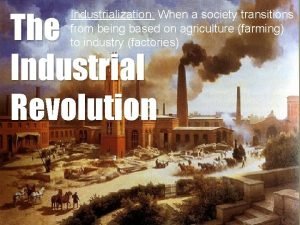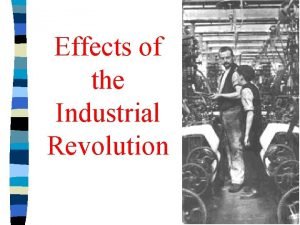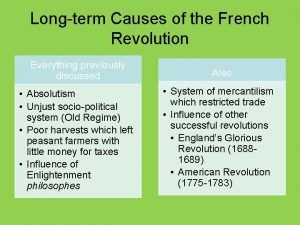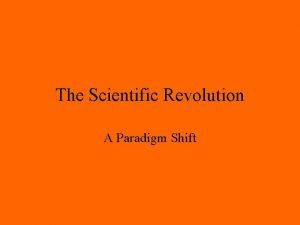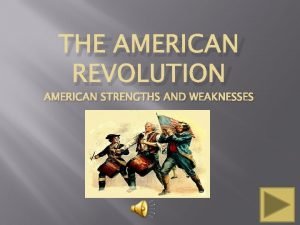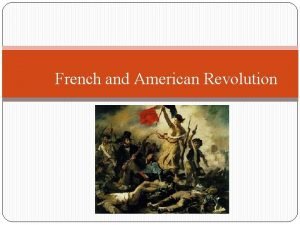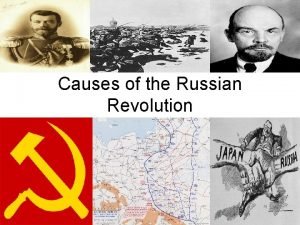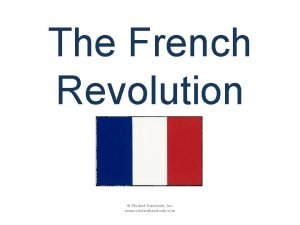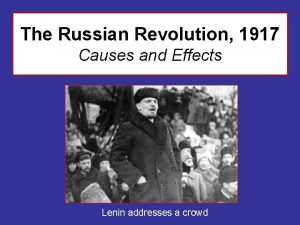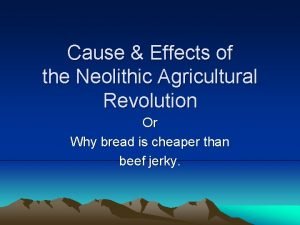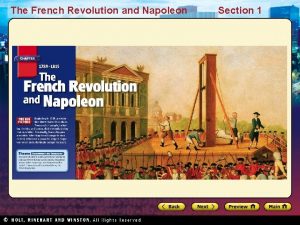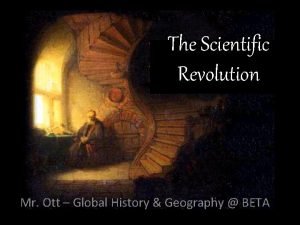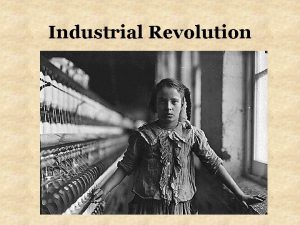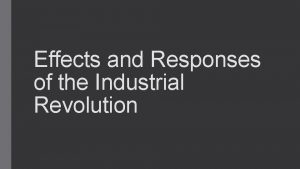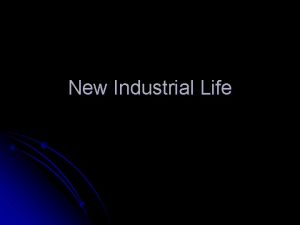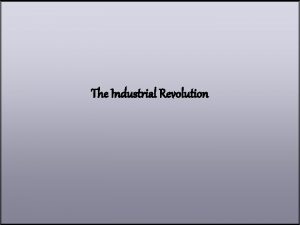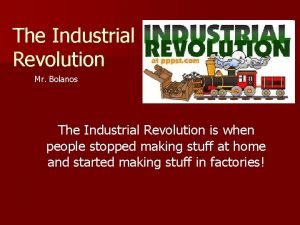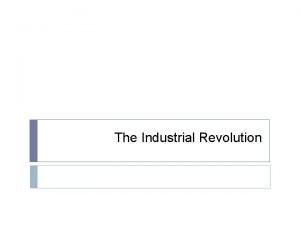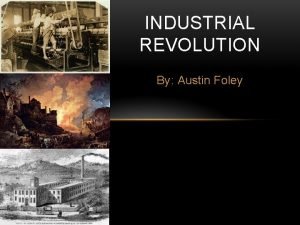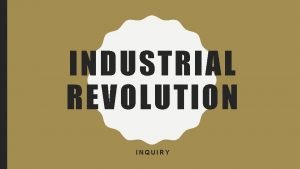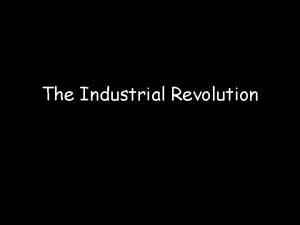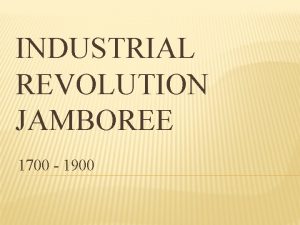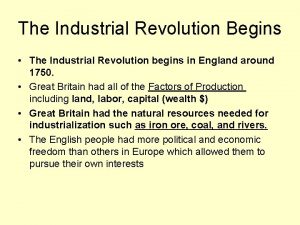Industrial Revolution Effects of the Industrial Revolution What

















!["When the steam flowed in under the rising piston [of the Newcomen engine], Watt "When the steam flowed in under the rising piston [of the Newcomen engine], Watt](https://slidetodoc.com/presentation_image_h2/4c41a68c1af1929f7d1d8dffddcda649/image-18.jpg)












- Slides: 30

Industrial Revolution

Effects of the Industrial Revolution • What was the industrial revolution? – Machines coordinated to make goods – Energy from non-animal sources – Industry grew 4 times faster • Changed all aspects of society – Most profound effect since agriculture – Government change • Political and military balance • Europe as dominant power – Transformed social classes – Higher standard of living for most

Reasoning • • • The Agricultural Revolution Population Growth Financial Innovations The Enlightenment and the Scientific Revolution Navigable Rivers and Canals Coal and Iron World Trade The Cottage Industry The Large and Lucky Continent of Eurasia

Effects of the Industrial Revolution

Effects of the Industrial Revolution

Origins • Agricultural revolution – Horse and steel plow – Fertilizer use – Yields improved 300% 1700 -1850 • Growth of foreign trade for manufactured goods – Foreign colonies – Increase in ships and size • Successful wars and foreign conquest

Origins – Why England? • Factors in England – No civil strife – Government favored trade – Laissez faire – Large middle class – Island geography – Mobile population – Everyone lived within 20 miles of navigable river – Tradition of experimental science – Weak guilds Wall street

"What were the factors that already marked Britain, rather than any other European country, as the destined first home of the industrial revolution? The answer lies partly in things remote from technology, such as the religious freedom which brought in the Huguenots and other refugees with their numerous arts and encouraged the native Puritan capitalist. There was the confident attitude natural to an island people that had ceased. . . to reckon seriously with the prospect of invasion. The island possessed a valuable stimulus to trade in its long coastline and frequent navigable rivers. . . Moreover, the Act of Union in 1707 had made Britain into a single economic unit long before any other area of comparable wealth and resources had ceased to be divided by numerous customs barriers. But even with the addition of the Scots, the smallness of the population as compared with the French gave at the same time an important incentive to the use of laborsaving devices. Lastly, there was the plentifulness and accessibility of coal in the island. " – T. K. Derry and T. I. Williams, A Short History of Technology

"In most of Europe, then, craft guilds eventually became responsible for a level of regulation that stifled competition and innovation. They did this by laying down meticulous rules about three elements of production that we might term 'the three p's': prices, procedures, and participation. " – Mokyr, Joel, The Gifts of Athena, Princeton University Press, 2002, p. 259.

"The weak position of the guilds in Britain in the eighteenth century can go some way in explaining the series of technological successes we usually refer to as the British Industrial Revolution and why it occurred in Britain rather than on the European continent, although clearly this was only one of many variables at work. " – Mokyr, Joel, The Gifts of Athena, Princeton University Press, 2002, p. 260.

Manufacturing • Textiles – Manchester—center of revolution – 22% industrial production due to textiles – 4 -5 spinners per weaver

Manufacturing Textiles • Cotton gave stronger fibers • Invention of Spinning Jenny – Demand for skilled weavers • Mechanical looms (flying shuttle) • Jacquard looms

Manufacturing Textiles • Mechanical looms (flying shuttle) • Jacquard looms

Manufacturing Textiles • Jacquard looms

Manufacturing Negatives • Poor working conditions • Children supplied labor • Luddites – Handicraftsmen replaced by machine – Organized to stop industrialization

Energy and Transportation • Animal power and plant burning • Water emerged as energy source • Iron industry energy crisis – Lack of wood – Coal discovered – Steam pumps for mines • Steam engines • Railroads

"Newcomen's engine consisted mainly of a large, vertical piston and a beam that rocked back and forth on a central support like a giant seesaw. The piston sat several feet below one end of the beam, attached to it by a chain. Each time the piston moved downward, it would pull down on that end of the rocking beam, forcing the other end up. The opposite end was attached to a suction pump, similar to the hand-operated pumps you still see on come old water wells, and each downstroke of the piston would bring gallons of water gushing up through a pipe from the mine below. " – Pool, Robert, Beyond Engineering, Oxford University Press, 1997, p. 122.
![When the steam flowed in under the rising piston of the Newcomen engine Watt "When the steam flowed in under the rising piston [of the Newcomen engine], Watt](https://slidetodoc.com/presentation_image_h2/4c41a68c1af1929f7d1d8dffddcda649/image-18.jpg)
"When the steam flowed in under the rising piston [of the Newcomen engine], Watt realized, all but a fraction of it condensed immediately because the surrounding cylinder–having just been cooled by a jet of water–was at a relatively low temperature. This meant that several times as much steam was used–and several times as much fuel was consumed–as was theoretically sufficient to fill the piston on each stroke. . . Watt suddenly realizsed how to fix the problem: build a machine with a condensing chamber separate from the cylinder and keep the two at different temperatures. " – Pool, Robert, Beyond Engineering, Oxford University Press, 1997, p. 124 -125.

England vs. Continental Europe

England vs. Continental Europe • Produced 20% of industrial goods • Gross national product rose 4 x • Population increase • Inventors took inventions abroad • Belgium’s coal and iron resources • Germany iron and wool factories • France slow to industrialize • Mechanization came but late


Phases

Technology • The Industrial Revolution was built on rapid advances in technology

"Technology comprises all that bewilderingly varied body of knowledge and devices by which man progressively masters his natural environment. . . " - T. K. Derry and T. I. Williams, A Short History of Technology, 3

Technology • Is technology good?

Technology: short, medium and long-term consequences Short-term: Benefits are helpful and desirable (this is why we use it). If proven to be a dud, it is discarded quickly. Medium-term: Negative consequences are noted and strong resistance often arises. Sometimes the short term causes disruptions (loss of jobs, etc. ) and attempts are made in the medium term to stop technology (Luddites, etc. ); but these are rarely successful (except current efforts by environmental groups who have the backing of politicians, courts, and many people). This resistance is outside market forces. Long-term: May require changes/evolution in the technology but we rarely abandon the technology all together because the benefits are great and the negatives are worked around. – Mokyr, Joel, The Gifts of Athena,

Technology • Is complexity good?

"Complexity creates unpredictability. The more complex a system, the more difficult it is to understand all the different ways the system may behave–and, in particular, to anticipate all the different ways it may fail. Interdependence among parts creates entirely new ways that things can go wrong, ways that engineers often overlook or ignore. Thus many technological failures chalked up to mechanical breakdown or design flaws are more accurately described as the children of complexity. " – Pool, Robert, Beyond Engineering, Oxford University Press, 1997, p. 131.

Technology • How do we control technology without stifling creativity?

Thank You Tucker
 Negative effects of the industrial revolution
Negative effects of the industrial revolution Negative effects of the industrial revolution
Negative effects of the industrial revolution The effects of the industrial revolution meme
The effects of the industrial revolution meme Positive effects of the industrial revolution
Positive effects of the industrial revolution Effects of the industrial revolution
Effects of the industrial revolution Negative effects of the industrial revolution
Negative effects of the industrial revolution Long term causes french revolution
Long term causes french revolution Causes and effects of french revolution
Causes and effects of french revolution Scientific revolution effects
Scientific revolution effects Strengths of the continental army
Strengths of the continental army What were the effects of the scientific revolution?
What were the effects of the scientific revolution? Outcome of french revolution
Outcome of french revolution Haitian revolution effects
Haitian revolution effects Russian revolution effects
Russian revolution effects French revolution causes and effects
French revolution causes and effects Effect of russian revolution
Effect of russian revolution Immediate cause of french revolution
Immediate cause of french revolution Unit 9 the green revolution
Unit 9 the green revolution French revolution causes and effects
French revolution causes and effects Causes and effects of the russian revolution
Causes and effects of the russian revolution Cause and effect neolithic revolution
Cause and effect neolithic revolution French revolution
French revolution Effects of scientific revolution
Effects of scientific revolution What was the social cause of french revolution
What was the social cause of french revolution Third agricultural revolution definition
Third agricultural revolution definition Russian revolution vs french revolution
Russian revolution vs french revolution You should hope that this game will be over soon
You should hope that this game will be over soon Các châu lục và đại dương trên thế giới
Các châu lục và đại dương trên thế giới Từ ngữ thể hiện lòng nhân hậu
Từ ngữ thể hiện lòng nhân hậu Diễn thế sinh thái là
Diễn thế sinh thái là Tư thế ngồi viết
Tư thế ngồi viết
